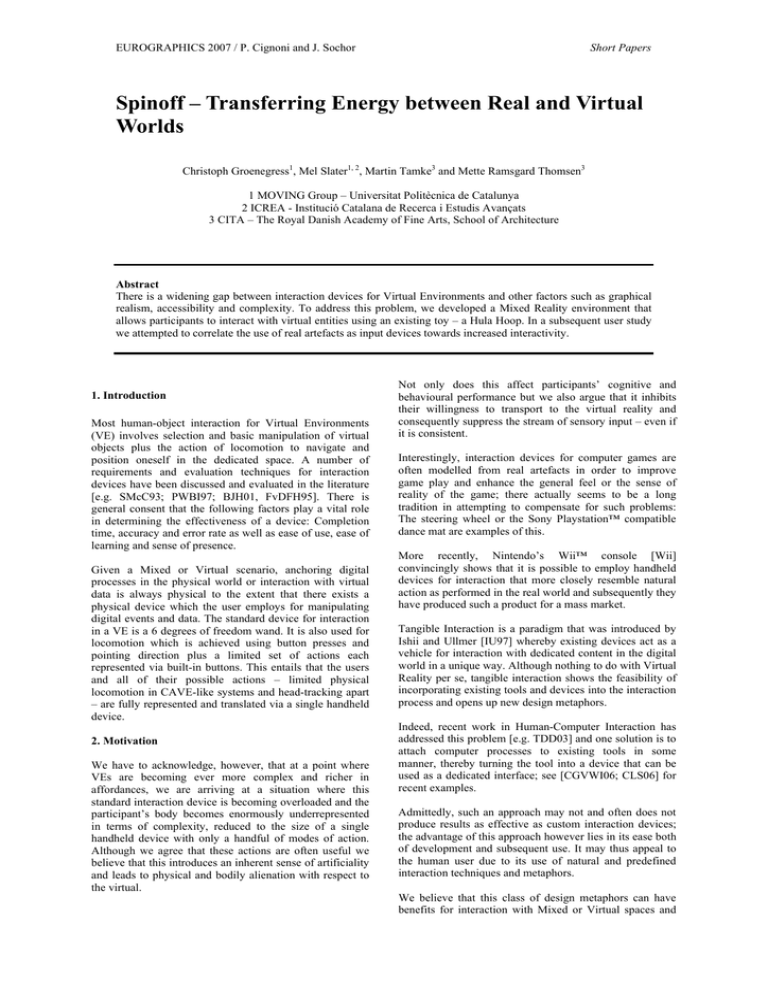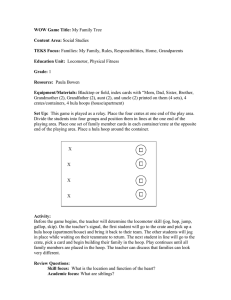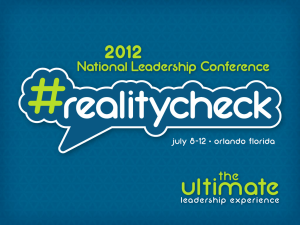Spinoff – Transferring Energy between Real and Virtual Worlds
advertisement

EUROGRAPHICS 2007 / P. Cignoni and J. Sochor Short Papers Spinoff – Transferring Energy between Real and Virtual Worlds Christoph Groenegress1, Mel Slater1, 2, Martin Tamke3 and Mette Ramsgard Thomsen3 1 MOVING Group – Universitat Politècnica de Catalunya 2 ICREA - Institució Catalana de Recerca i Estudis Avançats 3 CITA – The Royal Danish Academy of Fine Arts, School of Architecture Abstract There is a widening gap between interaction devices for Virtual Environments and other factors such as graphical realism, accessibility and complexity. To address this problem, we developed a Mixed Reality environment that allows participants to interact with virtual entities using an existing toy – a Hula Hoop. In a subsequent user study we attempted to correlate the use of real artefacts as input devices towards increased interactivity. 1. Introduction Most human-object interaction for Virtual Environments (VE) involves selection and basic manipulation of virtual objects plus the action of locomotion to navigate and position oneself in the dedicated space. A number of requirements and evaluation techniques for interaction devices have been discussed and evaluated in the literature [e.g. SMcC93; PWBI97; BJH01, FvDFH95]. There is general consent that the following factors play a vital role in determining the effectiveness of a device: Completion time, accuracy and error rate as well as ease of use, ease of learning and sense of presence. Given a Mixed or Virtual scenario, anchoring digital processes in the physical world or interaction with virtual data is always physical to the extent that there exists a physical device which the user employs for manipulating digital events and data. The standard device for interaction in a VE is a 6 degrees of freedom wand. It is also used for locomotion which is achieved using button presses and pointing direction plus a limited set of actions each represented via built-in buttons. This entails that the users and all of their possible actions – limited physical locomotion in CAVE-like systems and head-tracking apart – are fully represented and translated via a single handheld device. 2. Motivation We have to acknowledge, however, that at a point where VEs are becoming ever more complex and richer in affordances, we are arriving at a situation where this standard interaction device is becoming overloaded and the participant’s body becomes enormously underrepresented in terms of complexity, reduced to the size of a single handheld device with only a handful of modes of action. Although we agree that these actions are often useful we believe that this introduces an inherent sense of artificiality and leads to physical and bodily alienation with respect to the virtual. Not only does this affect participants’ cognitive and behavioural performance but we also argue that it inhibits their willingness to transport to the virtual reality and consequently suppress the stream of sensory input – even if it is consistent. Interestingly, interaction devices for computer games are often modelled from real artefacts in order to improve game play and enhance the general feel or the sense of reality of the game; there actually seems to be a long tradition in attempting to compensate for such problems: The steering wheel or the Sony Playstation™ compatible dance mat are examples of this. More recently, Nintendo’s Wii™ console [Wii] convincingly shows that it is possible to employ handheld devices for interaction that more closely resemble natural action as performed in the real world and subsequently they have produced such a product for a mass market. Tangible Interaction is a paradigm that was introduced by Ishii and Ullmer [IU97] whereby existing devices act as a vehicle for interaction with dedicated content in the digital world in a unique way. Although nothing to do with Virtual Reality per se, tangible interaction shows the feasibility of incorporating existing tools and devices into the interaction process and opens up new design metaphors. Indeed, recent work in Human-Computer Interaction has addressed this problem [e.g. TDD03] and one solution is to attach computer processes to existing tools in some manner, thereby turning the tool into a device that can be used as a dedicated interface; see [CGVWI06; CLS06] for recent examples. Admittedly, such an approach may not and often does not produce results as effective as custom interaction devices; the advantage of this approach however lies in its ease both of development and subsequent use. It may thus appeal to the human user due to its use of natural and predefined interaction techniques and metaphors. We believe that this class of design metaphors can have benefits for interaction with Mixed or Virtual spaces and EUROGRAPHICS 2007 / P. Cignoni and J. Sochor Short Papers greatly enhance the experience compared to current technology. Not only does the transfer between real and virtual inherently become more physical but the less techsavvy user may also feel less inhibited using such technology. It thus has the potential to lead to a more engaging and realistic experience. 3. The Spinoff System 3.1 Objectives We were invited by The Royal Danish Academy of Fine Arts to contribute to an exhibition on Architecture and Play during the month of November in 2006. We designed and implemented a Mixed Reality (MR) interaction space in which we intended to visualise energy transfer between the real and the virtual realm and thus between the visitor of the exhibition and some virtual entity. Energy, in this sense, is determined by the participant’s actions, transferred to the system via suitable sensors, which in turn changes the entity’s behaviour in a predefined and consistent way. Last but not least, the experience should be entertaining. 3.2 Hula Hoop Interface We decided to use an ordinary Hula Hoop ring as the interface since it is easy to derive an energy measure from its usage (and everyone who has used it once will confirm that it is indeed very exhausting to hula hoop!). Being a toy that requires physical engagement the interface is aimed at emphasizing movement, timing, emotion and fun rather than functionality and efficiency. Thus, it promotes physical activity and pleasure over complexity of interaction. Figure 1: Initial design sketch for Spinoff. 3.4 Mixing Real and Virtual Environments The space itself consisted of an interaction space in front of a large projection screen displaying stereoscopic imagery from two projectors (see Figure 1 for an initial design and Figure 2 for the resulting space). Wearing a pair of polarized glasses provided allowed the participants to see the visual output in 3-D. A webcam installed above the interaction space monitors the space and the participants’ movements when present. All image processing and tracking-related software was implemented using OpenCV [OCV]. 3.3 Virtual Environment Our virtual entity consisted of a simple Boids system [Rey97] whose particles are attracted to and swirl around a central vertical axis in front of the participant. The Boids system encompasses a simple model of motions and emergent behaviour of groups of animals such as flocks of birds or fish. The general idea is to make a group of objects that move on the same trajectory appear to have their own identity by allowing them to change some of their movement parameters individually without losing track of the general direction and speed of motion. The flocking model consists of three simple steering behaviours which describe how an individual Boid manoeuvres based on the positions and velocities of nearby Boids. The Boids themselves consist of strobe rings as depicted in Figure 3. Figure 2: Photograph of the actual space in the exhibition centre. Regarding energy transfer we devised a simple system of four energy states including transitions of raising or lowering the energy. The differences between them should be reflected by the behaviour of the Boids system. These energy states acted as the actual interface or input to the system. (1) Idle – no one is inside the action space. The Boids’ behaviour is completely determined by the internal rule system and no exterior energy is added; (2) Person present – A person has entered the action space although without a Hula Hoop. The Boids’ energy level is raised and they become more agitated; (3) Person and/or Hula Hoop present – The energy level is raised even more if a Hula Hoop. EUROGRAPHICS 2007 / P. Cignoni and J. Sochor Short Papers 4. User Study & Evaluation (4) Person is Hula Hooping – The energy level is raised to its highest level. The energy states should be clearly distinguishable from each other which should also be reflected during the transitions. For instance, when one drops the Hula Hoop during hula-hooping, the effects of this should become immediately apparent and some energy needs to be taken out of the system. For additional energy qualities we chose colour of the Boids, agitation (e.g. velocity, spread) number of visible Boids. For detecting people in the image we perform simple background subtraction. We detect Hula Hoops using the Hough Transform to detect ellipses in an image [e.g. Bal81]. By tracking the position of the Hoop we can monitor how well a person is Hula Hooping. So, in order to reach the 4th energy state for instance, the Hoop needs to spin around a fixed or moving centre at a certain velocity, otherwise we classify it as stationary, and set the energy state to 3. Figure 3: Idle (top) and agitated Boids (bottom). We conducted a user study with 22 (8 male and 14 female) volunteering visitors of the exhibition in two groups. Since the study was conducted during the exhibition, participants were ordinary visitors who we invited to take part in our study. Experimental group A was presented with the normal interactive environment while any effort from a participant of control group B had no effect on the development of the Boids system and was therefore not interactive whatsoever. After the experience participants were handed out a questionnaire comprised of 20 questions that makes use of some of the questions in the Witmer and Singer Questionnaire for presence [WS98]. However, we used it to not in order to measure presence but to assess the quality of the experience and the interaction. There was a significant difference at the 10% level but not at 5% between the groups in their perceived sense of control of the environment and impact of one’s own actions, where those in group A had the higher mean questionnaire scores. There was also a significant difference at the 5% level between the groups with respect to the perceived identification with the VE: Results from group A showed that the more the output of the VE was meaningfully attributed to one’s own body movements (which was lacking for group B since the system’s response was random), the more likely one was to associate with it. In addition the perceived time spent in the environment was also positively and significantly correlated with this response variable. These analyses were carried out using normal Analysis of Covariance, and in both cases a Bera-Jarque test did not reject the hypothesis of normality of the residual errors. EUROGRAPHICS 2007 / P. Cignoni and J. Sochor Short Papers References [Bal81] BALLARD D.H.: Generalizing the Hough transform to detect arbitrary shapes, Pattern Recognition, 13, 1981. [BJH01] BOWMAN, D. A. , JOHNSON, D. B., HODGES, L .F.: Testbed Evaluation of Virtual Environment Interaction Techniques. Presence: Teleoperators & Virtual Environments 10(1): 75-95, 2001. [CGVWI06] CARVEY, A., GOULDSTONE, J., VEDURUMUDI, P. WHITON, A. ISHII, H.: Rubber shark as user interface. Extended abstracts on Human Factors in Computing Systems (CHI '06), 2006. Figure 4: Visitor interacting with the Boids system. We were also able to confirm one interesting aspect regarding presence, namely that one necessary condition for presence is consistency of the stream of sensory input and the expected outcome [cf. GS05], a property that we refer to as correlational presence. 5. Conclusions We presented a MR environment that allows participants to interact with virtual entities using an existing toy – a Hula Hoop. The virtual environment consists of a set of Boids that display emergent behaviour and react toward the actions of the participant. We employed a real toy as an interaction device for a virtual environment thereby merging two different domains: a real space that is characterized by a physical interface that is not custommade but exploited for use with VEs. We demonstrated that using such a toy (in a real space) can yield a set of “commands” for a computer interface, which is not only interesting for interaction designers regarding interface design and interaction metaphors, it also stresses the simplicity of the interface itself. Although we were not able to show the effectiveness of adapting design metaphors from tangible interaction to VR we have created a playful interaction space that aims to reduce the gap between real and virtual spaces in an entertaining fashion. We were also able to verify a vital aspect of Presence, namely consistency between the streams of sensory input. Regarding future work, the installation itself could be improved by experimenting with different types of inputs. For instance, we could use the participants’ positions in the space as an attractor for the Boids or as some other kind of variable. Another possibility would be to extend the space and allow for multi-user action and interaction which would increase the number of possible scenarios even further. We intend to pursue this broad concept of using existing tools for interaction in VEs in the future and carry out further experiments determine its feasibility and whether this significantly increases interactivity with a VE. Acknowledgments This work is funded under the European Union FET project PRESENCCIA Contract Number 27731. [CLS06] CHUNG , H., LEE, C.-H. J., SELKER, T.: Lover's cups: drinking interfaces as new communication channels. Extended abstracts on Human Factors in Computing Systems (CHI '06), 2006. [FvDFH95] FOLEY, J. D., VAN DAM, A., FEINER, S., HUGHES, J. F.: Computer Graphics: Principles and Practice, Addison-Wesley Publishing, 1995. [GS05] GILLIES, M., SLATER, M., Non-Verbal Communication for Correlational Characters, The 8th Annual International Workshop on Presence: Presence 2005,103-106, University College London, 2005. [IU97] ISHII, H., ULLMER, B.: Tangible bits: towards seamless interfaces between people, bits and atoms. CHI '97: Human Factors in Computing Systems, Atlanta, Georgia, United States, 1997. [PWBI97] POUPYREV, I., WEGHORST, S., BILLINGHURST, M., ICHIKAWA, T.: A framework and testbed for studying manipulation techniques for immersive VR. Proceedings of VRST, Lausanne, Switzerland, 1997. [Rey87] REYNOLDS, C.: Flocks, herds and schools: A distributed behavioral model. SIGGRAPH '87, ACM, 1987. [SMcC93] SANDERS, M. S., MCCORMICK, E. J.: Human Factors in Engineering and Design. New York, McGraw-Hill, 1993. [TDD03] TOLLMAR, K., D. DEMIRDJIAN and DARELL, T. Gesture + Play: Exploring Full Body Interaction for Virtual Environments. Human Factors in Computing Systems, 2003. [WS98] WITMER, B., SINGER, M.: Measuring presence in virtual environments: A presence questionnaire. Presence: Teleoperators and Virtual Environments 7(3): 225-240, 1998. [Wii] http://wii.com/ [OCV] http://sourceforge.net/projects/opencvlibrary/


